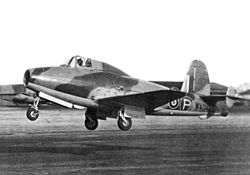Gloster E. 28/39
| Gloster E. 28/39 | |
|---|---|
 Prototype W4041 of the Gloster E.28 / 39 |
|
| Type: | Experimental airplane |
| Design country: | |
| Manufacturer: | |
| First flight: |
May 15, 1941 |
| Commissioning: |
only prototype |
| Number of pieces: |
2 |
The Gloster E.28 / 39 (factory designation G.40 ) was the first British jet aircraft and also the first of the Allies in World War II . The official first flight was made by Flight Lieutenant Gerry Sayer on May 15, 1941, 21 months after the German Heinkel He 178 . The flight lasted 17 minutes and the machine reached a top speed of 544 km / h.
history
The designer of the E.28 / 39 was George Carter , the chief designer at Gloster at the time. Whittle and Carter had a meeting on April 28, 1939, at which Whittle handed over a rough sketch of his own for the test carrier of his engine. Carter converted this sketch into a design. In order to examine the interactions between the engine and firing machine guns, armament should also be installed. However, this was not implemented.
The Power Jets W1 engine was designed by Frank Whittle , one of the inventors of the jet engine , and was installed behind the cockpit and tank.
Only two copies of the E.28 / 39 were built: the W4041 with the W1 engine and the W4046 with the more powerful W2 engine. The W4046 took off for the first time in May 1943. It was lost in the course of the flight attempts when the ailerons jammed at a great height and the test pilot Squadron Leader Douglas Davie was the first British pilot to parachute out of a jet aircraft.
The W4041 survived all other tests in which the W500 engine was also installed and is now in the British Science Museum in Kensington .
The knowledge gained through the E.28 / 39 flowed into the G.41 project - the twin-jet Gloster Meteor . This was followed by the first mass-produced single-engine British jet aircraft, the De Havilland DH 100 "Vampire" - notably an aircraft with a double tail unit, like the first draft of the E.28 / 39.
Technical specifications
| Parameter | Data from Gloster E. 28/39 W4041 with W1 engine |
|---|---|
| length | 7.72 m |
| span | 8.84 m |
| Wing area | 28.0 m² |
| drive | a Power Jets W1 |
| Top speed | 544 km / h |
| Service ceiling | 9755 m |
| Range | 660 km |
| crew | 1 |
| Empty mass | 1300 kg |
| Max. Takeoff mass | 1700 kg |
See also
Web links
Individual evidence
- ^ Bill Gunston: Early Jet Aircraft (Database). Airplane Monthly, May 2001, p. 60.
